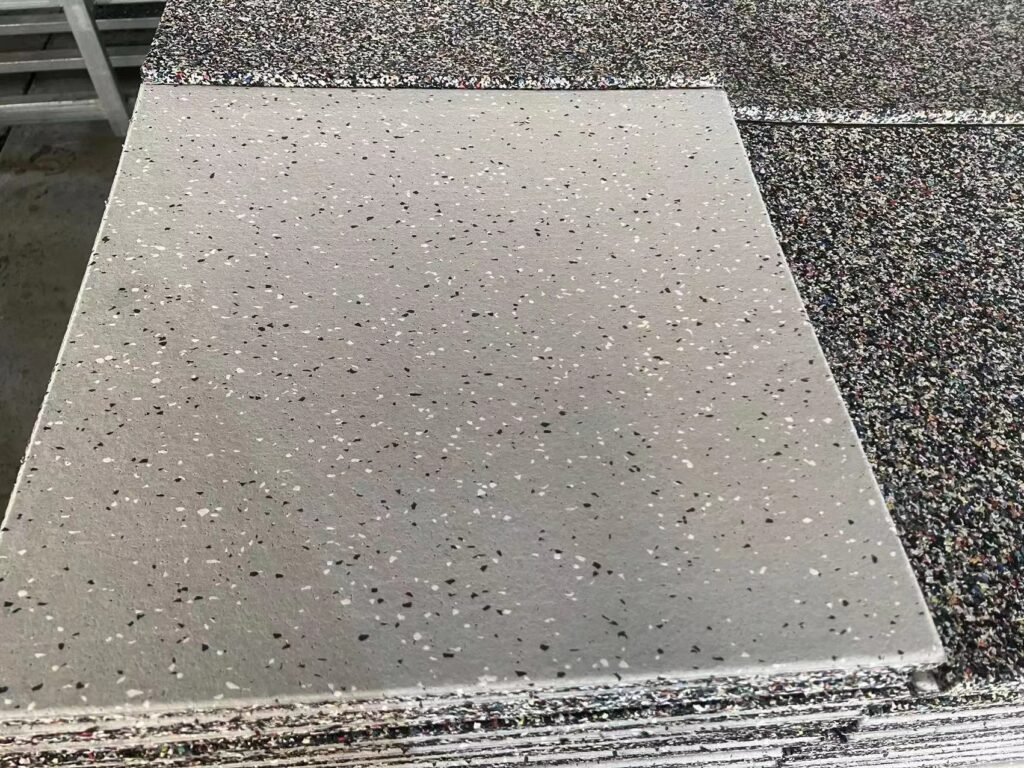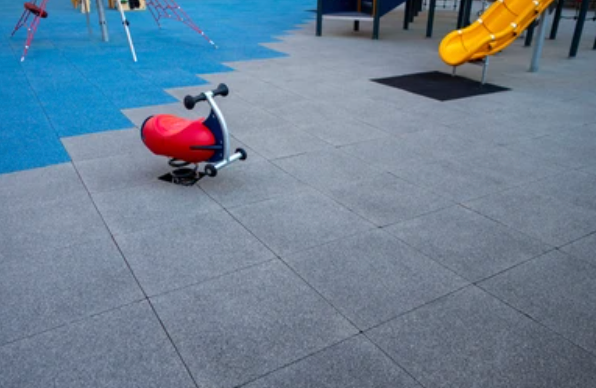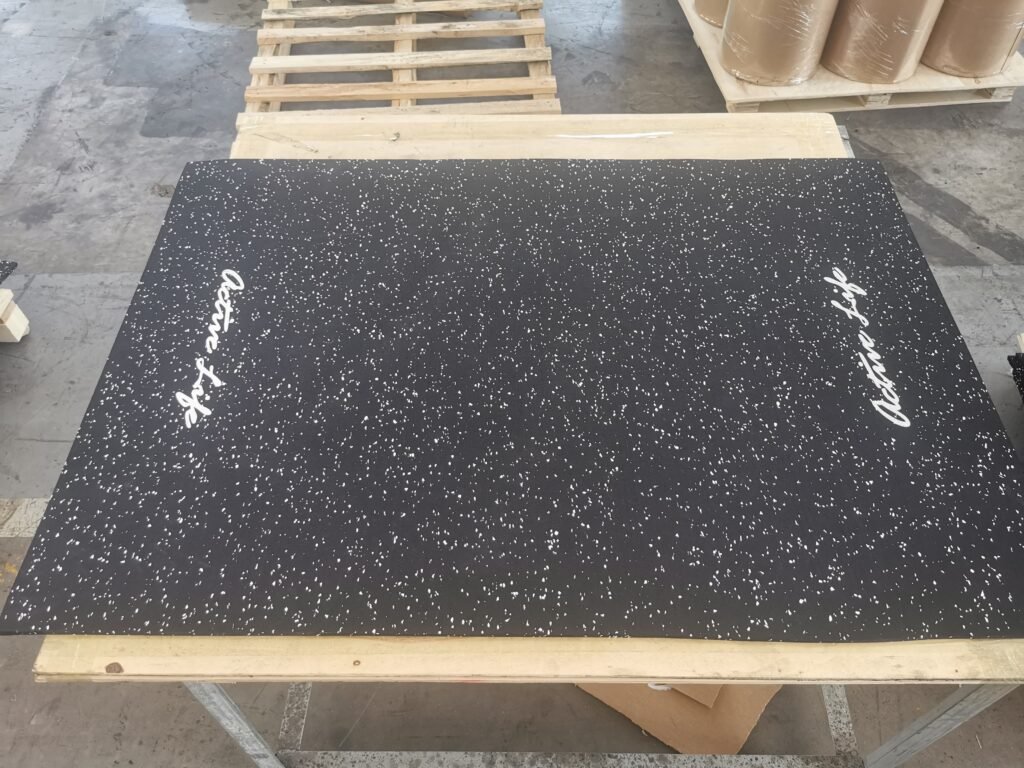surface but setting the foundation for your health and workouts. Non-toxic gym flooring is necessary for a safe, smell-free, and sustainable workout environment. In this post, we’ll cut through the clutter to reveal top non-toxic materials that promise safety durability, and are kind to our planet. Ready for a breath of fresh air? Let’s find that ideal gym floor that supports your burpees and well-being.

Why Can Non-Toxic Gym Flooring Change the Lifestyle of Health-Conscious Fitness Enthusiasts?
If you count macros, track steps, or meditate for mental clarity, you know that a healthy lifestyle doesn’t stop at the gym door. It starts from the ground up—quite literally—with the flooring you’re lunging, jumping, and downward-dogging on. Non-toxic gym flooring is more than a buzzword for the wellness crowd; it’s a crucial piece of the holistic health puzzle.
Maintaining Indoor Air Quality
Think about the hours you spend in your gym. Imagine breathing in harmful emissions from toxic flooring materials—like volatile organic compounds (VOCs)—during your workouts. Not so serene, right? Non-toxic materials, such as EVA foam or recycled rubber, are low in VOCs, which means they don’t off-gas chemicals into your sacred sweat space. This is vital for maintaining indoor air quality, especially in areas where you’re huffing and puffing your way to good health.
The Hidden Dangers of Toxic Gym Flooring
Toxic gym flooring can be a silent saboteur. Some conventional flooring options release small amounts of chemicals into the air long after they’ve been installed. These emissions can cause a range of health issues, from headaches and dizziness to more serious respiratory problems over time. For the health-conscious, this is a no-go.
Moreover, while durable, certain types of rubber flooring may contain traces of heavy metals or harmful chemicals, which can percolate into the air you breathe or the water you drink if they’re not properly sealed or degrade over time.
Choosing non-toxic gym flooring isn’t just a personal health choice; it’s an investment in your continuous well-being. It’s about ensuring that your environment aligns with your health goals, allowing you to focus on getting stronger, faster, and healthier without worrying about the air you breathe. After all, what’s the point of a clean diet and a rigorous fitness regime if your gym floor is undermining your health?
By selecting non-toxic gym flooring, you’re not just crafting a workout space; you’re curating a lifestyle that places well-being at the forefront. And that, my fitness friends, is a game-changer.

Tackling Top Questions on Gym Flooring Choices
Choosing the suitable surface for your fitness sanctuary at home often leads to a workout of its own—sifting through many home gym flooring options. To ease your load, we’ve pulled together some FAQs and provided answers that hit the mark for practicality and safety. Let’s jump into these everyday curiosities with some straightforward insights.
Do Rubber Mats Release Harmful Emissions, and Will They Lessen Over Time?
The ‘new mat’ scent is a familiar one in the world of gym flooring. This aroma is typically associated with volatile organic compounds (VOCs) released from rubber mats, a byproduct of the manufacturing process. While most rubber mats, including those from brands like Rubber Flooring Inc., are designed to meet stringent safety standards, the initial off-gassing can be a concern for the more health-conscious among us.
Fortunately, this is a temporary setback. To minimize the presence of VOCs, try these tips:
- Ventilate the area by installing the mats in a space where air can circulate freely.
- Employ a gentle cleaning solution, and consider a sprinkle of baking soda for its odor-absorbing prowess.
- Keep the air moving with fans or open windows, reducing the VOC concentration more swiftly.
For those with a keen nose or respiratory sensitivities, alternatives such as high-density EVA foam tiles or cork may provide a more suitable, low-odor home gym flooring solution.

What Are Some Considerations When Selecting Rubber Flooring for Gyms?
Rubber flooring is a heavyweight champion in gym flooring options, lauded for its shock absorption and ability to handle the drop of free weights without a flinch. But even winners have their vulnerabilities. Here are a few considerations when it comes to rubber floors:
- Scent: A robust rubber scent can accompany new flooring due to the VOCs above. This can be particularly potent in enclosed gym spaces but tends to diminish over time.
- Temperature Reactivity: Rubber’s performance can vary with temperature changes. High heat may increase flexibility and odor, while cooler temps could lead to a firmer surface.
- Allergy Awareness: For those with latex sensitivities, verifying whether your rubber flooring is synthetic or natural is crucial, as the latter may trigger allergic reactions.
Despite these points, rubber remains a stalwart selection for areas subjected to heavy weights and rigorous routines. It’s a matter of balancing these factors with your personal needs and the specific demands of your exercise regimen.
Selecting the Ideal Non-Toxic Flooring for Your Fitness Needs
Embarking on the journey to find the perfect non-toxic flooring for your gym space can be as strategic as planning your workout routine. Whether it’s for a bustling commercial gym or a cozy corner in your home, the right flooring underpins the safety and effectiveness of your fitness endeavors. Let’s break down the process into manageable steps to ensure you get the best fit for your needs.
- Activity Analysis: Pinpoint the nature of your workouts. Will you be engaging in high-impact exercise or weight training? Opt for shock-absorbent rubber rolls or thick foam mats that can take the strain off your joints and handle the occasional drop of weights.
- Comfort Check: For those who prefer yoga or Pilates, a plush or extra-large exercise mat can provide the necessary cushioning and non-slip surface.
- Gauge Thickness: The density of your flooring can make a world of difference. Heavy equipment demands a robust top layer, such as that offered by recycled rubber flooring, to protect your floor and equipment.
- Space Measurement: Tailor your flooring choice to the dimensions of your gym space. Interlocking tiles or puzzle exercise mats are ideal for smaller spaces, while larger areas might benefit from the seamless look of rubber rolls.
- Durability Decision: Longevity is key. Recycled rubber flooring, sourced from recycled tires, stands up to rigorous use and is an eco-friendly choice for high-traffic areas like health clubs.
- Maintenance Mindfulness: Seek out options that promise ease of upkeep. Water-resistant and moisture-resistant materials like virgin rubber or high-density foam tiles will be more straightforward to clean and maintain.
- Budget Balancing: Align your flooring choice with your financial plan. Foam home gym flooring is often more budget-friendly, while premium options like virgin rubber may represent a longer-term investment.
By following this guide, you’ll be well-equipped to select non-toxic flooring that meets the specific demands of your workout regimen and gym environment.

Does Rubber Flooring Provide Variety in Design?
Modern rubber flooring isn’t just about functionality; it’s also about form. Today’s market offers a diverse palette of colors and textures, ensuring that your gym space, whether decked with hardwood floors or artificial turf, doesn’t compromise style. From the vibrant hues of gorilla mats to the classic elegance of wood floors and the eco-friendly appeal of recycled rubber flooring, a design suits every aesthetic. Textured options enhance the look and improve grip and safety, making them a favorite among fitness professionals.

Installing and Upkeeping Your Non-Toxic Gym Flooring
The longevity of your gym flooring is mainly contingent on proper installation and maintenance. Here’s how to keep your floors in peak condition:
- Installation: Adhere to the manufacturer’s guidelines. For DIY-friendly options like interlocking tiles or foam mats, ensure a clean, even subfloor. For larger installations, such as rubber rolls, professional fitting might be the best route to ensure a flawless finish.
- Cleaning: Regular cleaning with gentle products can keep your flooring in shape. For an eco-friendly approach, diluted vinegar can tackle most spills on water-resistant surfaces without introducing toxins.
- Ongoing Care: Regular inspections can catch early signs of wear. Individual foam tiles can be replaced as needed, and areas under heavy equipment should be monitored for indentations or damage.
- Smart Practices: Treat your flooring well. Dropping weights on a rubber floor should be done with care, and consider layering carpet tiles or extra exercise mats in high-traffic zones.
By prioritizing these best practices, you’ll ensure that your chosen non-toxic flooring—the cushioned comfort of foam home gym flooring or the rugged resilience of recycled rubber—remains a safe and inviting foundation for all your fitness activities.

FAQ Section: Top Questions About Gym Flooring Answered
Q1: What makes a play mat suitable for home workouts?
A1: A play mat is often made of foam and provides a cushioned, smooth surface perfect for floor exercises. It’s a versatile, gentle option on the joints, making it suitable for various home workouts.
Q2: Can I use the same flooring for my exercise equipment and workout area?
A2: Absolutely! The best home gym flooring, like thick foam flooring or a gorilla mat, is designed to support heavy workout equipment and provide a comfortable exercise surface.
Q3: What flooring is recommended for a home gym with limited space?
A3: Interlocking pieces like puzzle exercise mats are ideal for smaller home gyms. They can be customized to fit your space and offer excellent grip and cushioning for a variety of workouts.
Q4: How important is grip and texture for home gym flooring?
A4: Grip is crucial to prevent slipping during workouts. Flooring with an excellent grip, such as textured foam mats or specialized gorilla mats, can enhance safety and performance.
Q5: What’s the best way to reduce noise in my workout area?
A5: Opt for foam flooring or rubber mats to reduce noise, especially if you’re in a multi-level home or apartment. They absorb the sound of drop weights and movement from high-impact exercises.
Q6: Are there any low-odor flooring options for sensitive individuals?
A6: Yes, there are lower odor options available. High-quality virgin rubber mats or EVA foam mats tend to have less odor than other materials and are favored in most gyms.

Q7: What should I look for in flooring if I do a lot of floor exercises?
A7: Look for a flooring option that provides a smooth surface and enough padding to protect your body during floor exercises. A thick puzzle exercise mat or a layered foam mat can offer the necessary support.
Q8: How can I protect my natural wood floors if I want to use them for home workouts?
A8: To protect natural wood floors, use a non-slip, protective layer like a large exercise mat or interlocking foam tiles. This will prevent scratches and damage from workout equipment.
Q9: What’s the best gym flooring for high-impact exercises like dropping weights?
A9: Rubber mats and high-density foam flooring are best for absorbing the impact of dropping weights. They provide shock absorption and protect the subfloor from damage.
Q10: How do I choose the best home gym flooring that’s functional and aesthetically pleasing?
A10: Consider the overall look you want to achieve, the types of workouts you’ll be doing, and the level of maintenance you’re willing to undertake. Many gym flooring options, like wood-effect interlocking pieces or sleek black gorilla mats, combine functionality with style to complement your workout area.


